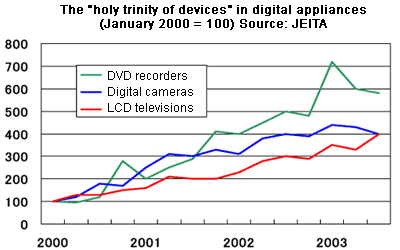It is said that the principal role in the battle for sales in the year-end bonus season last year was played by digital appliances. Particularly popular were liquid-crystal display (LCD) televisions, DVD recorders, and digital cameras - the so-called "holy trinity of devices." Sales of LCD televisions increased by 50% up on the previous year, while sales of DVD recorders doubled, showing a force exceeding that of the IT bubble (see graph). Although the anticipation on the part of the home-electronics industry of reliving the dreams of the postwar high-growth years can be heard in the expression "holy trinity of devices," could this holy trinity of devices really propel Japanese economic growth in the same way past home-electronics devices (ie televisions, refrigerators and washing machines) have done?

Lessons from personal computers and semiconductors
This holy trinity of devices differs from past products in that their internals more closely resemble those of computers than those of home electronics. An LCD television is made up of a series of large semiconductors and, with the exception of the lens, a digital camera consists primarily of semiconductors. The hard disk drives included in DVD recorders are now capable of holding up to 250 gigabytes of data (over 100 hours of television programming), a capacity that in the past could only be achieved by large-scale computing centers. For this reason, the structure of this industry should be considered closer to those of the personal-computer and semiconductor industries than to that of the home-electronics industry.
This is not very good news for Japan, as the personal-computer and semiconductor fields are both ones in which Japan has been unable to compete in the international marketplace. In the 1980s, when the IBM PC became the global personal-computer standard and low-cost PC-compatible computers assembled from modular parts procured on a global basis appeared around the world, only Japanese manufacturers stuck to proprietary standards such as PC-9800 and FM-Towns, continuing to produce products for the local market that did not achieve popularity around the world. By the time Japan finally began to produce PC-compatible (DOS/V) computers, the world's parts factories had already been concentrated in other Asian nations and the world's assembly plants in the United States. There was no room left for Japanese manufacturers.
In the case of semiconductors, in the 1980s Japan boasted an overwhelming 80% share of worldwide DRAM (dynamic random access memory) production. This large share had even become a source of trade friction. However, in the 1990s the progress of semiconductor manufacturing equipment and design tools led to the modularization of technology and a shift to manufacturing in other Asian countries. When price competition began with countries such as South Korea and Taiwan, Japan's strength collapsed. Today, only Elpida Memory, Inc., a joint venture of Hitachi and NEC, produces DRAM chips in Japan (see Discussion Paper [in Japanese]). The market for system LSI chips for home-electronics devices, in which Japan has specialized, is also destined for commoditization.
Toward policies to make Japan the content distribution hub for Asia instead of isolating it
One more characteristic of the digital appliance market is the fact that competition in this market has begun to transgress national borders and industrial boundaries. Major personal-computer manufacturers such as Dell, Hewlett-Packard and Gateway have already begun sales of LCD televisions. With its lowest-priced LCD television selling for $699, Dell has achieved a market share of 30% in the United States. Dell has contracts with companies in countries such as China and Taiwan to manufacture these televisions. As LCD technology is common around the world, such televisions can be assembled by procuring parts at a low cost, with no need to invest in development. Competition is taking shape along the same lines it previously did in the market for IBM PC-compatible computers.
As a result, attempting to use standards originating in Japan to corner the market, a course advocated by some, has resulted in a repetition of Japan's failures in the personal-computer market. Factor technologies are not important, but competition between the architectures under which these technologies are assembled is. The lesson to be learned from the Internet and mobile telephones is that successful competitors are those which have released open platforms, such as NTT DoCoMo's i-mode, and allowed large quantities of applications and content to be developed for them.
The key to successful digital appliances is also content. No matter how many digital appliances are sold as individual products, if no suitable new content appears for them the industry will not expand. Fortunately, Japan has a high level of content industries such as video games and animation, as well as the world's leading broadband infrastructure. Linking this with digital appliances - for example, by creating a system whereby video and audio from around the world could be dispatched to DVD recorders for recording onto hard disk drives - could enable a wide range of creators to distribute their content via broadband technology, without the need for real-time broadcasting. This would broaden the consumer's range of choices massively.
However, television broadcasters and record companies, who have such content available, are trying to protect their vested interests. For this reason, in the case of LCD televisions, such firms are merely broadcasting using terrestrial digital signals the same programs which are broadcast using analog signals, and they are prohibiting the distribution of such content via broadband. Furthermore, the government is proceeding with plans to revise copyright law in order to make it more restrictive, using policies such as the implementation of record importation rights (Japanese only) that would limit imports of CDs. If these trends continue, content will be bottlenecked, leading to the commoditization of digital appliances, which would result in the end of the bubble. Instead of these kinds of closed-door policies, in order for Japan to take the lead in Asia it needs to open the door to Asia's content creators, enabling Japan to become a hub for worldwide content distribution via broadband.


